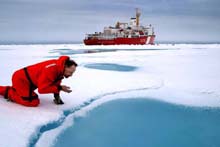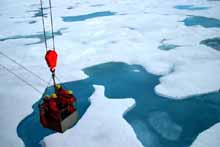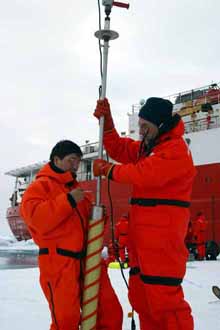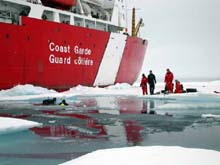
Russ Hopcroft, from the University of Alaska Fairbanks, takes a sip from one of the many melt ponds scattered around the ice. (Photo courtesy of Ian MacDonald.) Click image for larger view.
Impressions from the Ice
August 19, 2002
Jeremy Potter
NOAA Office of Ocean Exploration
![]() Watch a video of the science team as they conduct an ice core sampling. (mp4, 3.1 MB).
Watch a video of the science team as they conduct an ice core sampling. (mp4, 3.1 MB).
I stumbled around with a hot, wet blanket draped across my shoulders. At least that’s what it felt like surrounded by the heat and humidity of Washington, DC, in August. During those moments when I had a chance to ponder the upcoming cruise, thoughts of bundling up in long underwear, wool socks, and the rest of my warmest winter gear, then stomping around on a sea of ice, seemed ridiculous. But it was not too long after boarding the Louis that the fantasy became a shivering reality.
Ice analysis reports from Environment Canada suggested that we were in the midst of an extraordinary year; that the thick multiyear ice, difficult even for an immense icebreaker to crack, had moved much farther south than expected. Ironically enough, 5 days into our 25-day mission in the Canada Basin, only one group of scientists had not yet been able to begin its explorations: The sea-ice group. Despite the ice reports, the ship had yet to find ice thick enough for the scientists to walk and work on safely.

Crammed into the ship's basket, four explorers are slowly lowered onto the pack ice. (Photo courtesy of Ian MacDonald.) Click image for larger view.
Finally, on Aug. 18, it looked as if the sea-ice team would get a chance to explore the floating ice masses. Captain Mardsen brought the ship to a full stop near an ice sheet that looked solid. Scientists carried their sampling gear to the Louis’s bow and donned their bright orange mustang suits to protect themselves from the Arctic chill. Unfortunately, the ice was not strong enough to hold even an empty basket lowered from the ship. The excursion was quickly cancelled.
Circumstances improved on the evening of Aug. 19. Around 6 pm, the captain found a vast expanse of thick ice mottled with blue melt ponds. He parked the ship in the ice and gave the go-ahead for a portion of the science party to work on the floe.
The marine-mammal observers and sea-ice team were the first off the ship. The ship’s crew attached a large metal basket to the forward winch. Their faces beaming like children on an amusement park ride, three scientists quickly climbed inside. Once the winch lifted the basket over the side of the ship, the three willing riders, dwarfed by the immense ship, overlooked an expansive landscape most consider harsh and desolate. When the basket touched down on the ice, the explorers hurried to unload their gear so the empty basket could return to the ship and ferry over the next contingent of scientists.
Within 20 min, more than 20 scientists, safety officers, photographers, and under-ice scuba divers had landed on the ice. Many spent the first 5 min in awe. There is no easy way to describe one’s thoughts and feelings when the only substance holding you above 3,000 m of frigid Arctic water are a few meters of ice.
The giddiness we experienced with our first steps onto the frozen surface partially dissipated with the realization that our ice time was extremely limited. Given that we only had a few hours, it would be almost impossible to get all of our work accomplished. Those still on board lined the starboard side of the Louis, staring at the bright orange figures with gear in tow as they gingerly meandered around melt ponds and sought potential work areas both close to the ship and off in the distance. Hardly 30 m from the hull, divers shot video transects and still photos, and collected water samples for the sea-ice party. On the ice, scientists from China and the United States used power drills to collect cylindrical cores of ice and searched for life in the bright blue ponds on the ice surface. Within a few minutes, Canadian scientists moving away from the ship to calibrate an instrument had already become dark splotches on the horizon.
After a few hours, the organized chaos came to an end. Word passed across the ice that the captain was ready to move on. Everyone converged back at the base of the ship for the return trip in the basket.
Reluctantly plucked from the floe, I remembered descriptions of the Arctic ice as "harsh and desolate." While those terms rang true at first glance, "breathtaking and serene" now seemed more appropriate. Ten minutes after returning to the ship, it was hard to believe that the fantasy that began in muggy Washington, DC, had finally come true./p>
Sign up for the Ocean Explorer E-mail Update List.




























